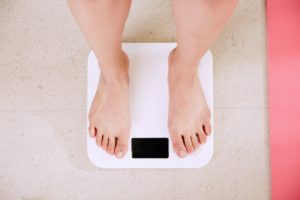Body image—we’ve all heard that buzz phrase. It’s become an umbrella term society uses to encompass anything from low self-esteem to eating disorders, and is especially common to hear in relation to women’s health.
What is Body Image?

Everyone has a body image, men included. Put simply, it is the way we view our body’s makeup, literally and figuratively. This can include our opinions on our weight, shape, height, muscle composition, and bone structure as well as how we perceive the goodness of those traits.
Despite what some may think, a poor body image is not indicative of an eating disorder, though it is highly linked to it, and a positive body image does not guarantee mental health, though it does increase its odds.
So if body image is a pretty simple concept, why has it become such a widely used phrase? In short, because the effects of a poor body image are vast, the amount of social influence on this concept is finally being recognized, and poor body image has been plummeting the self-esteem of children as young as 6 years old.
For these reasons, it is imperative we strive to understand the impact of body image issues and how we can support friends, family, children, and ourselves as we develop healthier views of our bodies.
Healthy Vs. Unhealthy Body Image
Before discussing the impact of a healthy or unhealthy body image, it is important to understand what a “good” body image is in comparison to a poor body image.
Healthy Body Image
Having a healthy body image involves a relatively neutral position on your body—this means recognizing its strengths, valuing all that it does for you, and not seeking to change your body’s makeup.
 Contrary to popular belief, having a positive body image does not mean posting numerous Instagram pictures saying that you love your body.
Contrary to popular belief, having a positive body image does not mean posting numerous Instagram pictures saying that you love your body.
Recently there has been a movement on social media of “loving your body,” and while the motives behind this are in the right place, it has perpetuated the idea that our bodies hold a significant amount of our value.
It has become a bragging right to say “I love my body,” yet often it leads to a negative outcome of objectifying our own bodies by putting them on a pedestal as the most important aspect of our being. It keeps bodies at center stage instead of the person in the body.
That’s not to say just because someone posts a picture mentioning loving their body is automatically negative—rather, it is to act as a reminder that there is more to our person than our bodies.
A healthy body image is simply accepting your body for what it is: the vessel you were given—a vessel of strength, beauty, and power, yes, but not something that dictates your worth.
Poor Body Image
A poor body image, on the other hand, usually consists of disliking your physical makeup, trying to change it, and often includes degrading your body in some way.
When people experience low body image, they are more likely to seek ways of changing it using drastic measures. This is why it is linked to disordered eating.
Unfortunately, a negative body image seems to be much more common than a positive body image. Seventy percent of women between ages 18 and 30 dislike their bodies, and 43 percent of men wish their bodies were different in some way. It is also important to note that eating disorders are the second highest killers in the mental health field behind opioid addiction.
If your body was a person, a healthy body image would speak to it saying things like, “I hear that hunger cue, let’s get some lunch,” “I’m really thankful you allow me to pick up my children,” or “Wow, I feel really strong today.”
A negative body image would say something like, “Your stomach is way too fat,” and may even tie morality to the body, saying things such as, “You need to work on self-discipline,” “How could you let yourself not work out again?” or “You should be ashamed of yourself for going down the candy aisle.”
In short, someone with a healthy body image will talk to their body like they would a friend, offering support as needed but mostly just walking through life with them. Someone with a poor body image will actively try to change it and likely degrade not only their body, but also other personal traits.
Effects of a Poor Body Image
 Body image starts either a negative or positive cycle in our wellbeing, hence its vast impact. For example, let’s say you start off with a poor body image.
Body image starts either a negative or positive cycle in our wellbeing, hence its vast impact. For example, let’s say you start off with a poor body image.
This will eventually impact your self-esteem (defined here as how you value yourself for all of who you are—traits, personality, and body included), because your self-esteem will eventually get tired of fighting the messages your poor body image is sending and begin internalizing them.
This will eventually lead to poor self-esteem, which has consistently been linked to mental health struggles like depression and anxiety, among others. These disorders have great comorbidity with eating disorders as well.
Therefore, what begins as a seemingly simple problem of not being a fan of your looks snowballs into a huge issue with incredible speed. For this reason, it is vital we address the issues contributing to poor body image early on in order to prevent the numerous negative effects of this problem.
 As mentioned earlier, part of the reason body image is such a wide and deep issue in our society is due to societal messaging. Messages about bodies are quite literally everywhere. Billboards, movies, television, social media platforms, song lyrics, magazines, and diet culture all constantly hound us with messages, usually unhealthy ones.
As mentioned earlier, part of the reason body image is such a wide and deep issue in our society is due to societal messaging. Messages about bodies are quite literally everywhere. Billboards, movies, television, social media platforms, song lyrics, magazines, and diet culture all constantly hound us with messages, usually unhealthy ones.
Part of why this is so dangerous is due to the fact they have become such a normal part of our daily lives that we no longer question their messages before internalizing them. We have become habituated to them.
For example, think of the countless diets that exist in our society. If diets worked, there would only be one—there would be no use for the other thousand. And yet magazines promote almost daily a new diet that can help women lose 10 pounds in a week.
Consider who we hire to model our clothes: the average model is 5’11 and 120 pounds. The average woman is 5’4 and 165 pounds (Body Image Therapy Center, 2019). This sends a message that what is beautiful is very different than the majority of the population.
Only a very small percentage of the population can healthily be at this size, and yet because of this, the vast majority of women try to shrink themselves to achieve it.
Not only so, but society has connected morality the issue of body size. Take Halo Top Ice Cream, for example. Halos are generally considered divine or angelic, clear moral beings. Connecting this to a “healthy” ice cream deems that food more morally acceptable.
Don’t get me wrong, I happen to love this ice cream and honestly their marketing is brilliant. Why? Because in connecting their product to a morally sound name, they remove the shame people experience in buying what is normally a “guilty pleasure.”
These are just a few examples of the ways society influences body image, often encouraging unhealthy measures to attain their definition of “health”—tall and thin.
Body Image in Children
Perhaps the most disheartening and concerning aspect of this issue is its significant presence in children.
Here are just a few statistics:
- 42% of girls in 1st-3rd grades want to lose weight
- 51% of girls ages 9-10 feel better about themselves when dieting
- 81% of 10 year olds are afraid of being fat
- At 9 years old, 9% have already tried vomiting to lose weight (Body Image Therapy Center, 2019)
- 35% of high schoolers who smoke do so to lose weight (Lampert, 2019)
Why is this happening to our kids? Some of it is due to the societal norms and pressures—our kids are not unaware of them. A little boy sees who the world considers heroes and notices they are all tall and buff, and though there has been some improvement, also usually white.
Some of it is due to what they see modeled by their parents. For example, a girl watching her mom get dressed while complaining about her body learns that her mom wants her own body to be different.
And some of it is due to well-meaning behavior that actually sends negative messages. Consider what happens when pre-pubescent girls go to the doctor and have started gaining weight, which is a natural outcome of the start of puberty. This puts them in the higher weight percentile and their moms start to worry due to her own internalized beliefs and asks the doctor what to do to help her daughter lose weight or be “healthier.”
In reality, there is nothing wrong with the daughter’s weight, but because it has reached a higher weight percentile, fear is triggered and the doctor provides ideas on eating and exercise to the parent.
These restrictions often lead to undernourishing the child, which is a major contributor of why binge eating begins when the child is old enough to control their food intake (Lampert, 2019). Not only does it contribute to negative eating patterns, but the daughter has now internalized the fear of gaining weight.
These are just a couple examples of how negative body image is penetrating the minds of our kids, and it is almost shocking how easily these messages are sent, thus proving the importance of understanding how body image is created.
Getting Help Developing a Healthy Body Image
Body image issues are rampant and connected to so many mental, emotional, and physical health issues. What makes it so difficult to improve body images across the board is the vast amount of negative influencers we face each day, and once they are internalized, they also become difficult to notice in the first place.
Understanding the impact of body image, the influence of societal norms, and the early age at which this issue is cropping up is key to fighting for healthy body image. It must start with us as we battle against the negative messages and begin internalizing healthy, accurate ones, or it will continue to trickle down into our children’s minds.
If you can see the signs of poor body image in yourself and are tired of fighting the negative internalized messages about your body on your own, contact a therapist. We will fight with you.
References
Body Image Therapy Center, 2019. Eating disorders facts and statistics.
Lampert, J., 2019. What’s the tipping point? When is it disordered eating vs an eating disorder and what to do about it. The Emily Project.
Photos:
“The Body Human”, Courtesy of Jairo Alzate, Unsplash.com, CC0 License; “Social Media”, Courtesy of Jakob Owens, Unsplash.com, CC0 License; “Weigh-in”, Courtesy of i yunmai, Unsplash.com, CC0 License; “Secrets”, Courtesy of Sai De Silva, Unsplash.com, CC0 License





